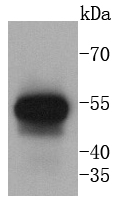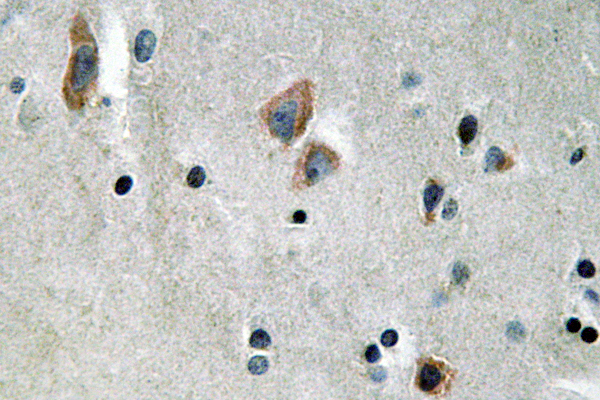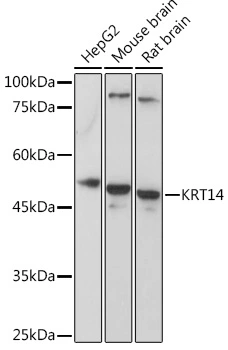Cytokeratin 14 antibody
GTX104124
ApplicationsImmunoFluorescence, Western Blot, ImmunoCytoChemistry, ImmunoHistoChemistry, ImmunoHistoChemistry Frozen, ImmunoHistoChemistry Paraffin
Product group Antibodies
TargetKRT14
Overview
- SupplierGeneTex
- Product NameCytokeratin 14 antibody
- Delivery Days Customer9
- Application Supplier NoteWB: 1:1000-1:10000. ICC/IF: 1:100-1:1000. IHC-P: 1:100-1:1000. *Optimal dilutions/concentrations should be determined by the researcher.Not tested in other applications.
- ApplicationsImmunoFluorescence, Western Blot, ImmunoCytoChemistry, ImmunoHistoChemistry, ImmunoHistoChemistry Frozen, ImmunoHistoChemistry Paraffin
- CertificationResearch Use Only
- ClonalityPolyclonal
- Concentration0.48 mg/ml
- ConjugateUnconjugated
- Gene ID3861
- Target nameKRT14
- Target descriptionkeratin 14
- Target synonymsCK14, EBS1, EBS1A, EBS1B, EBS1C, EBS1D, EBS3, EBS4, K14, NFJ, keratin, type I cytoskeletal 14, cytokeratin 14, keratin 14, type I
- HostRabbit
- IsotypeIgG
- Protein IDP02533
- Protein NameKeratin, type I cytoskeletal 14
- Scientific DescriptionThis gene encodes a member of the keratin family, the most diverse group of intermediate filaments. This gene product, a type I keratin, is usually found as a heterotetramer with two keratin 5 molecules, a type II keratin. Together they form the cytoskeleton of epithelial cells. Mutations in the genes for these keratins are associated with epidermolysis bullosa simplex. At least one pseudogene has been identified at 17p12-p11. [provided by RefSeq]
- Storage Instruction-20°C or -80°C,2°C to 8°C
- UNSPSC12352203
References
- Lin KL, Lu JH, Chueh KS, et al. Low-Intensity Extracorporeal Shock Wave Therapy Promotes Bladder Regeneration and Improves Overactive Bladder Induced by Ovarian Hormone Deficiency from Rat Animal Model to Human Clinical Trial. Int J Mol Sci. 2021,22(17). doi: 10.3390/ijms22179296Read this paper
- Moroki T, Matsuo S, Hatakeyama H, et al. Databases for technical aspects of immunohistochemistry: 2021 update. J Toxicol Pathol. 2021,34(2):161-180. doi: 10.1293/tox.2021-0006Read this paper
- Tang C, Liu C, Maffei B, et al. Primary ectocervical epithelial cells display lower permissivity to Chlamydia trachomatis than HeLa cells and a globally higher pro-inflammatory profile. Sci Rep. 2021,11(1):5848. doi: 10.1038/s41598-021-85123-7Read this paper
- Kim JY, Ohn J, Yoon JS, et al. Priming mobilization of hair follicle stem cells triggers permanent loss of regeneration after alkylating chemotherapy. Nat Commun. 2019,10(1):3694. doi: 10.1038/s41467-019-11665-0Read this paper
- Wang S, Qiu L, Meng X, et al. Knock-down of filaggrin influences the mitogen-activated protein kinases signaling pathway in normal human epidermal keratinocytes. Med Sci (Paris). 2018,34 Focus issue F1:94-98. doi: 10.1051/medsci/201834f116Read this paper
- D'Amico S, Shi J, Martin BL, et al. STAT3 is a master regulator of epithelial identity and KRAS-driven tumorigenesis. Genes Dev. 2018,32(17-18):1175-1187. doi: 10.1101/gad.311852.118Read this paper
- Fan JR, Lee HT, Lee W, et al. Potential role of CBX7 in regulating pluripotency of adult human pluripotent-like olfactory stem cells in stroke model. Cell Death Dis. 2018,9(5):502. doi: 10.1038/s41419-018-0519-8Read this paper
- Lee YL, Lin KL, Chuang SM, et al. Elucidating Mechanisms of Bladder Repair after Hyaluronan Instillation in Ketamine-Induced Ulcerative Cystitis in Animal Model. Am J Pathol. 2017,187(9):1945-1959. doi: 10.1016/j.ajpath.2017.06.004Read this paper
- Dang NN, Pang SG, Song HY, et al. Filaggrin silencing by shRNA directly impairs the skin barrier function of normal human epidermal keratinocytes and then induces an immune response. Braz J Med Biol Res. 2015,48(1):39-45.Read this paper
- Dang N, Pang S, Song H, et al. Knockdown of filaggrin influences the epidermal terminal differentiation via MAPK pathway in normal human epidermal keratinocytes. Mol Biol Rep. 2015,42(2):337-43. doi: 10.1007/s11033-014-3765-6Read this paper







